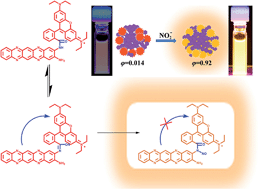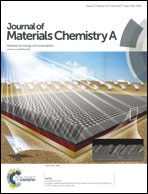Photoinduced electron transfer of poly(o-phenylenediamine)–Rhodamine B copolymer dots: application in ultrasensitive detection of nitrite in vivo†
Abstract
We demonstrate a new semiconducting polymer dot: the poly(o-phenylenediamine)–Rhodamine B copolymer dot (Pp–RhB dot), which emits in the red wavelength range. The Pp–RhB dots can be used as an ultrasensitive fluorescence probe for NO2−in vivo and show high selectivity and ultrasensitivity (detection limit: 2.0 × 10−11 M) for NO2−. The fluorescence of Pp–RhB dots is decreased (φ = 0.014) as a result of fast photoinduced electron transfer (PET) between the modulator (poly(o-phenylenediamine)) and the transducer (RhB), but the N–NO2 bonding mode prevents PET, causing the fluorescence emission to be enhanced (φ = 0.92). This probe effectively avoids the influence of auto-fluorescence in biological systems and gave positive results when tested in both aqueous solution and living cells.


 Please wait while we load your content...
Please wait while we load your content...